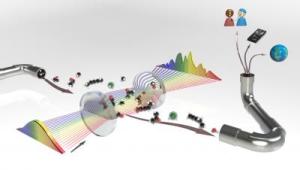Oct 15 2010
Scientists at JILA and collaborators have demonstrated an improved laser-based "molecular fingerprinting" technique that picks out traces of key hydrogen-containing and other molecules from a billion other particles in a gas in just 30 seconds or less—performance suitable for breathalyzers for diagnosing disease, measuring trace gases in the atmosphere, detecting security threats and other applications.
JILA is jointly operated by the National Institute of Standards and Technology (NIST) and University of Colorado at Boulder (CU).
 This is an artist's rendering of JILA's molecular fingerprinting system. A gas mixture (left) is probed by a frequency comb, a laser-based tool for identifying different colors of light.
This is an artist's rendering of JILA's molecular fingerprinting system. A gas mixture (left) is probed by a frequency comb, a laser-based tool for identifying different colors of light.
Described in Optics Express, the research extends the range of an existing NIST/JILA invention to cover the mid-infrared region of the electromagnetic spectrum. This is a critical range, because it includes the frequencies associated with strong molecular vibrations, including various hydrogen bonds. The technology thus can identify a much wider variety of molecules, including virtually any containing hydrogen—the most common element in the universe—and can measure lower concentration levels than before.
The heart of the JILA system is an optical frequency comb, a tool generated by ultrafast lasers that precisely identifies a wide range of different colors of light. Researchers identify specific molecules based on which colors of light, or comb "teeth," are absorbed by a gas, and in what amounts. The comb light usually passes through a gas mixture many times, significantly improving detection sensitivity. Concentrations are measured with the help of molecular "signatures" assembled from databases. The technique works quickly and reliably even when molecules have overlapping, continuous, or otherwise confusing absorption signatures. The rapid data collection, in particular, makes the technology suitable to replace or surpass conventional Fourier transform infrared (FTIR) spectrometers for many applications, according to the paper.
In the demonstration, scientists measured a dozen important molecules at parts-per-billion precision, including the greenhouse gases methane, carbon dioxide, and nitrous oxide; and the pollutants isoprene and formaldehyde. In addition, the system detected molecules useful in human breath analysis: ethane (a sign of asthma) and methanol (a sign of kidney failure). The system is able to reach parts-per-trillion sensitivity for the first time in detecting carbon dioxide.
Collaborators from IMRA America, Inc. (Ann Arbor, Mich.), developed the fiber laser used to make the frequency comb. The comb itself is based on a non-linear optical process that shifts the light from the near-infrared to the mid infrared. The JILA researchers now plan to extend the system further into longer wavelengths to cover a second important molecular fingerprinting region, to identify a more diverse set of complex molecules containing carbon, and to modify the equipment to make it portable. Planning is also under way for clinical trials of the breathalyzer application.
Source: http://www.nist.gov/